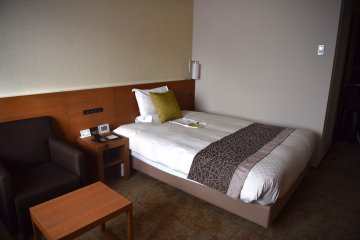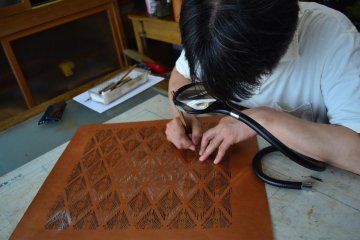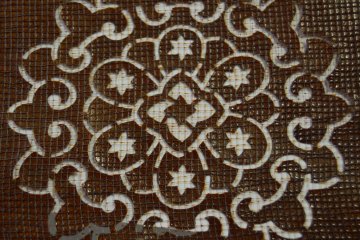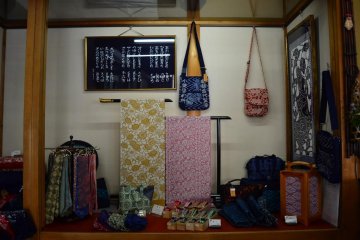Japan is home to many different dye patterns, each with its own distinctive regional flavour. Nambu Dye Shop has been producing its distinctive style of dyed fabrics since the mid-seventeenth century. The present day Nambu Dye Shop is found after crossing over Yugaosebashi bridge (fine views of Mount Iwate can been seen on a clear day), located about 12 mins walk from Morioka station. Visitors are not only welcome to browse the shop front but are also invited to learn more about the history of Nambu dye by visiting the shop museum on the 2nd floor.
Here, the production process of Nambu dye is introduced through eye-catching displays that use a combination of photography, exhibits taken from the production process, and other historic items with close ties to the shop. On this occasion, I was lucky enough to see a display of porcelain dolls dating from the 18th century put on display in celebration of boy's day (one of the five Japanese sekku celebrations). Among the items on display, was a traditional stencil or kata used to create the dye patterns. Stencils are made from Japanese paper washi that are infused in shibu (an astringent extract from Japanese persimmons) in order to make the paper more water resistant. Through the addition of shibu, stencils can be used for many times over without losing their shape.
Two main steps are required to make the pattern on the stencil. The first one is drawing the pattern, the second is to cut out the pattern using a very small and sharp knife. In a hidden corner at the back of the small factory adjacent to the shop, there is a storage area where stencils dating from one-hundred or more years ago are preserved. The interesting feature about old stencils is that they are smaller than those in use now. This is because people are larger today than they were in the past, and this has influenced the the size and dimensions of the patterns currently in use.
Nambu dye shares some characteristics with dyed fabrics produced in other countries such as China and Indonesia. Exhibits from both of these countries can be found in the 2nd Floor museum. One characteristic that differs from that of other countries is the use of rice glue that is wiped over the stencils, leaving the design shape adhered to the fabric when the stencil is peeled away. The following stencil is aligned next to the glue design adhered to the fabric, wiped with rice glue and peeled away. This process is repeated until a whole section of plain fabric is coated with the pattern. The use of rice glue gives rise to a very clearly defined pattern, as it retains its shape strongly, and is easily removed when the dyed fabric is washed in water. Stencil design currently in use by Nambu dye shop incorporates the best of traditional designs that have been handed down from craftsman to craftsman over the centuries.
The fabric with the glue pattern adhered is suspended between two bamboo posts with the pattern facing the ground. Water is lightly brushed on to the plain back of the fabric that in turn, is scraped with a knife. This step helps ensure that the rice glue is properly absorbed into the fabric. In unison, craftsmen flip the fabric over such that the design faces upwards and insert thin bamboo sticks at 10cm intervals along it to prevent creases appearing in the design. Charcoal burners are inserted beneath the fabric to accelerate the initial drying process, although the fabric is raised further up the bamboo posts to dry naturally after about twenty minutes.
A unique feature of Nambu dye has developed through the relative isolation of Iwate in former times. Whereas many dyed fabric manufacturers divided various aspects of the production process, such as stencil design, glue adhering and dyeing, among different vendors, Nambu dye came to control the entire production process from finish to end.
Dyeing was originally performed by adding the fabric to large earthenware pots buried up to the rim in the ground and although the pots are still used, they are now inserted inside a modern machine where conditions optimal to dyeing can be maintained though monitoring of and maintenance of the temperature.
The shop itself is divided into two sections. One section houses rolls of exquisite fabric, predominantly showing due blue hues of traditional aizome dyeing and kimono. The other, houses a very attractive range of different wares all made using the same traditional dye process. Everything from purses, wallets, bags, cloths, hanko cases, coasters and more is on sale. For those of you who are interested in traditional arts and crafts, or are in search of something quintessential to Iwate, a visit to Nambu dye shop when in Morioka is a recommended addition to any travel itinerary.










